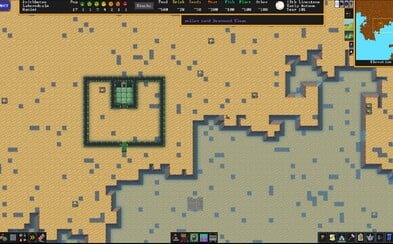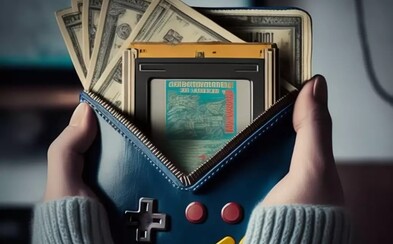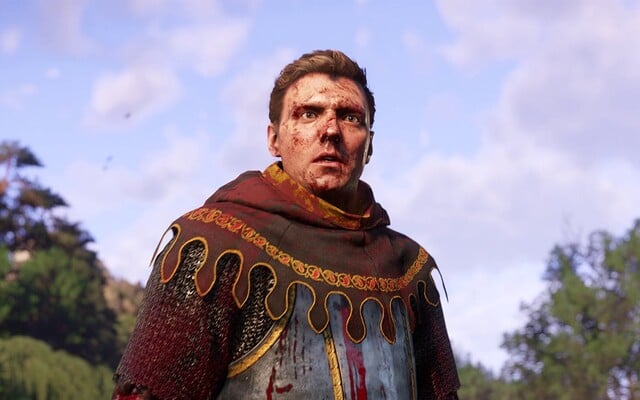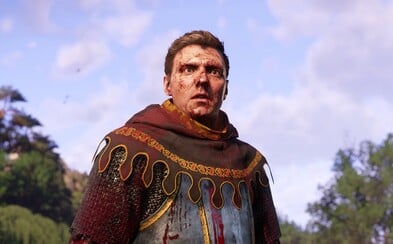 Kingdom Come: Deliverance 2 - the most elaborate RPG in gaming history, but also a frustrating medieval simulator (Review)
Kingdom Come: Deliverance 2 - the most elaborate RPG in gaming history, but also a frustrating medieval simulator (Review)
Kingdom Come: Deliverance 2 - the most elaborate RPG in gaming history, but also a frustrating medieval simulator (Review)
Kingdom Come: Deliverance 2 - the most elaborate RPG in gaming history, but also a frustrating medieval simulator (Review)
Making of Doom: The Game That Changed The Video Game Industry Forever
John Romero and John Carmack were game revolutionaries generations ahead of their time. How did the 20-year-old developers get together and what broke them apart?
If problems persis, please contact administrator.
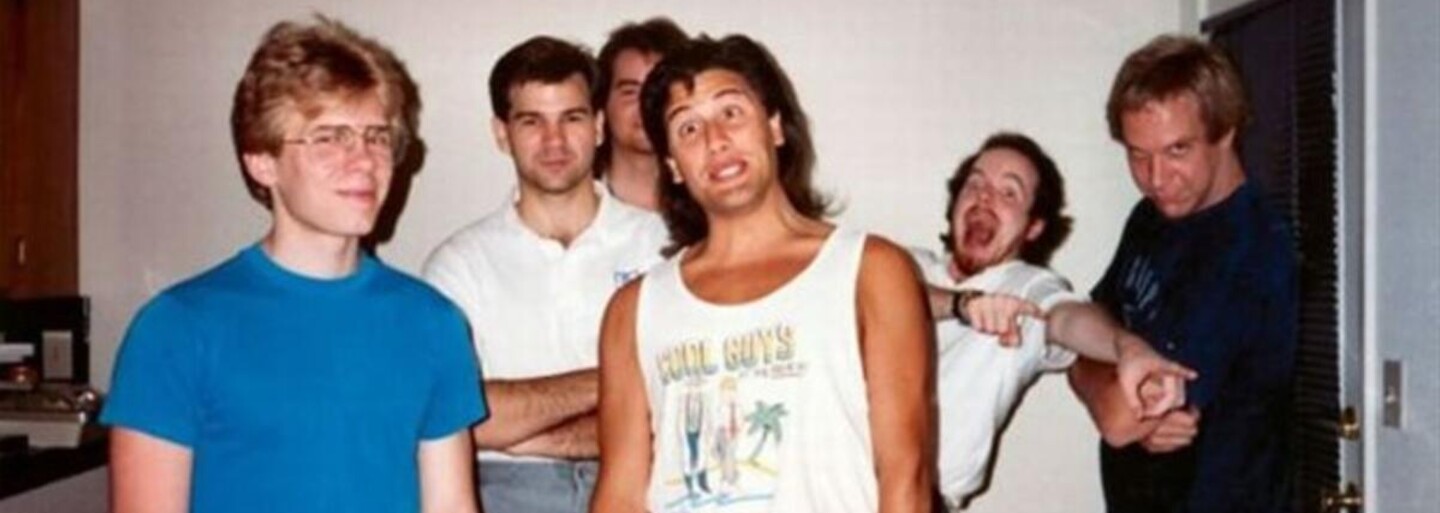
In 1995, Doom was installed on more computers than Microsoft Windows. Meanwhile, eight young boys were sitting in Id Software's offices, listening to metal, eating pizza, and thinking about taking over the game world, this time with the game they called Quake.
John Romero once inadvertently locked himself in his office while playing Doom. Instead of waiting for the locksmith, John Carmack took his custom made 5,000-dollar battle ax, busted the door, open and kept it in the hallway as a souvenir. The Id Software guys were having a lot of fun and the world was at their feet. The boys were barely over 20 years old, became millionaires and changed the video game industry forever with every game they put out.
View this post on Instagram
None of them were ready for the revolution caused by the creation of their games. Eventually, however, they got into multiple disputes and left the studio one by one. The 20-year-old boys literally waded through rivers to be able to code games at night and no one can deny their well-deserved status in the gaming industry.
Unless otherwise stated in the article (via blue links), all information in the article comes from the excellent Masters of Doom book, which captures the origins of Id Software and the development of Doom.
- How the young guys surpassed the billion-dollar company of Bill Gates.
- How they changed the gaming industry and game modding.
- Bizarre stories behind the games of Doom, Wolfenstein 3D or Quake.
- Why the founding members of Id Software got into disputes and left the company.
John Romero coded for the U.S. Air Force prior to the creation of Doom
John Romero was a long-haired rocker who enjoyed spending long hours in arcades, playing video games. He learned to program as a child.
In the 1980s, he developed several smaller games as well as a secret software for the U.S. Air Force. In 1989, the 23-year-old Romero began working for Softdisk, where he founded the Gamer’s Edge gaming division within one year.
He hired the 20-year-old programmer John Carmack, the 20-year-old artist Adrian Carmack (not related to John Carmack) and convinced the 26-year-old Tom Hall to come and help them after work.
john romero at softdisk as a new employee, taken for a company newsletter (1989) https://t.co/mlc3FXqNvo pic.twitter.com/fASk9r5vqi
— weirdo (@vg_history) April 9, 2021
The guys quickly outgrew the entire Softdisk and started experimenting. They knew computer games were the future. However, they didn't have enough power at that time. For example, they couldn't display the environment smoothly.
In just one night, John Carmack did with the game code what others couldn't accomplish in 9 years
John Carmack managed to program it in just one night after work. It was more than clear that he was a computer genius. Together with Tom Hall, they transformed the entire level of Super Mario Bros. 3, put it on a floppy disk and left it on Romero's keyboard. When Romero saw what they had accomplished, he had a euphoric revelation that they should leave Softdisk and make games of their own.
James & Dave Franco will produce the pilot for MASTERS OF DOOM, based on the book that tells the story of John Carmack, John Romero and the creation of DOOM at id Softwarehttps://t.co/CxiraYRfcJ pic.twitter.com/neV9td52HK
— Nibel (@Nibellion) June 27, 2019
Scott Miller from the Apogee publishing house approached them to create a game. Tom Hall came up with the idea for a sci-fi called Commander Keen. At the time, Apogee didn't sell games traditionally, but via a revolutionary shareware system. The first part of the game was released for free, and if someone wanted to gain access to the rest, they had to order it by phone from the publishing house. Everyone tried the game, which helped to spread them all over the world.
The first game was a big hit
However, the guys still worked for Softdisk and only worked on Keen in their spare time. On Friday after work, they loaded the company computers from Softdisk into their cars and "borrowed" them for the whole weekend. Romero and John Carmack were programmers, Tom Hall was designer and creative director, Adrian Carmack took care of the game's appearance, and Jay Wilbur joined them as a manager.
John Carmack and John Romero from id Software working on a Super Mario Bros. 3 clone for the PC (early 1990's) pic.twitter.com/eFYHqtRxmj
— VintagePhotos (@NotableHistory) July 20, 2014
Commander Keen's first trilogy was released on December 14th, 1990 and it was a great success. While Apogee was making about 7,000 dollars a month at the time, Commander Keen made 30,000 dollars in the first 10 days.
Commander Keen, 1990
Two months later, on February 1st, 1991, John Romero, John Carmack, Adrian Carmack, and Tom Hall founded Id Software.
Wolfenstein 3D was a technological revolution and a bestseller
After breaking with the game Catacomb 3-D, which was technologically great but insignificant, the developers of Id Software agreed to create a more ambitious 3D title with Apogee. Romero then acquired the rights to Castle Wolfenstein for several thousand dollars from the bankrupt company and they decided to make Wolfenstein 3D.
Id Software valued Apogee very much. They promised 50% of Wolfenstein's sales, which was unheard of in the gaming industry at the time. In addition, they received 100,000 dollars. One day, Formgen (who later released their next game, Spear of Destiny), warned Id Software that Wolfenstein was too brutal. Romero and co reacted to that remark by adding more blood, Nazi anthem Horst Wessel Lied and German screams to the introduction.
Famous Death Cam animation from Wolfenstein 3D

Wolfenstein 3D took 6 months to develop. It was the first 3D game with digital sound to run at 70 frames per second. It was an instant hit. Id Software expected to make 60,000 dollars in the first month. However, the Apogee check was 100,000 dollar instead. Wolfenstein 3D became the ultimately best-selling shareware product of 1992.
Nintendo called with a request to make Wolfenstein 3D available on their Super Nintendo Entertainment System (SNES) console. When an external collaborator didn't fix the game for that in 9 months, they just went ahead and did it themselves. They managed to learn console technology and remake the visual of the game in console code in incredible 3 weeks. At the same time, they had to flip the killing of dogs for rats, because Nintendo had a problem with that (there was no problem whatsoever with killing the Nazis).
John Romero was moving on towards design at the time, while John Carmack improved the programming environment in which they designed the game on a daily basis. The rest of the team worked on a Wolfenstein bonus game called Spear of Destiny. John Carmack committed to moving 3D technology even further.
Just released a new 1994 poster in the shop - on sale for €10 until the end of the week. Also on sale - get all three posters for €25! https://t.co/lZPmxsynsJ #DOOM #DOOM2 pic.twitter.com/LFHaIRAFZr
— 𝕵𝖔𝖍𝖓 𝕽𝖔𝖒𝖊𝖗𝖔 (@romero) June 18, 2021
Doom has arrived
However, they still did not have a fictional name for their next project. John Carmack revealed that they were inspired by a scene from The Color of Money with Paul Newman and Tom Cruise. When someone asked Cruise's character what was in the billiard cue box, Cruise's character just smiled devilishly and said, "Doom".
"What followed in the film was seen as our own influence on the gaming industry," said John Carmack.
Inspired by the board game Dungeons & Dragons, they exchanged Nazi soldiers for demons. Worked long nights, often up to 18 hours, 7 days a week. They had minimum of sleep, ate pizza, listened to metal and coded until the sun came up.
Tom Hall created an additional material for the game called Doom Bible. It summed up everything about the world, the demons and the story. However, John Carmack stopped him with the words: "The story in the game is like a story in porn. Everyone expects there to be one, but it's not very important."
Doom was supposed to be much more detailed than Wolfenstein. They modeled all of the monsters and weapons and later scanned them in their offices, which they called Suite 666. The monsters were modeled for them by a Hollywood expert, but they bought the weapons at a toy store.
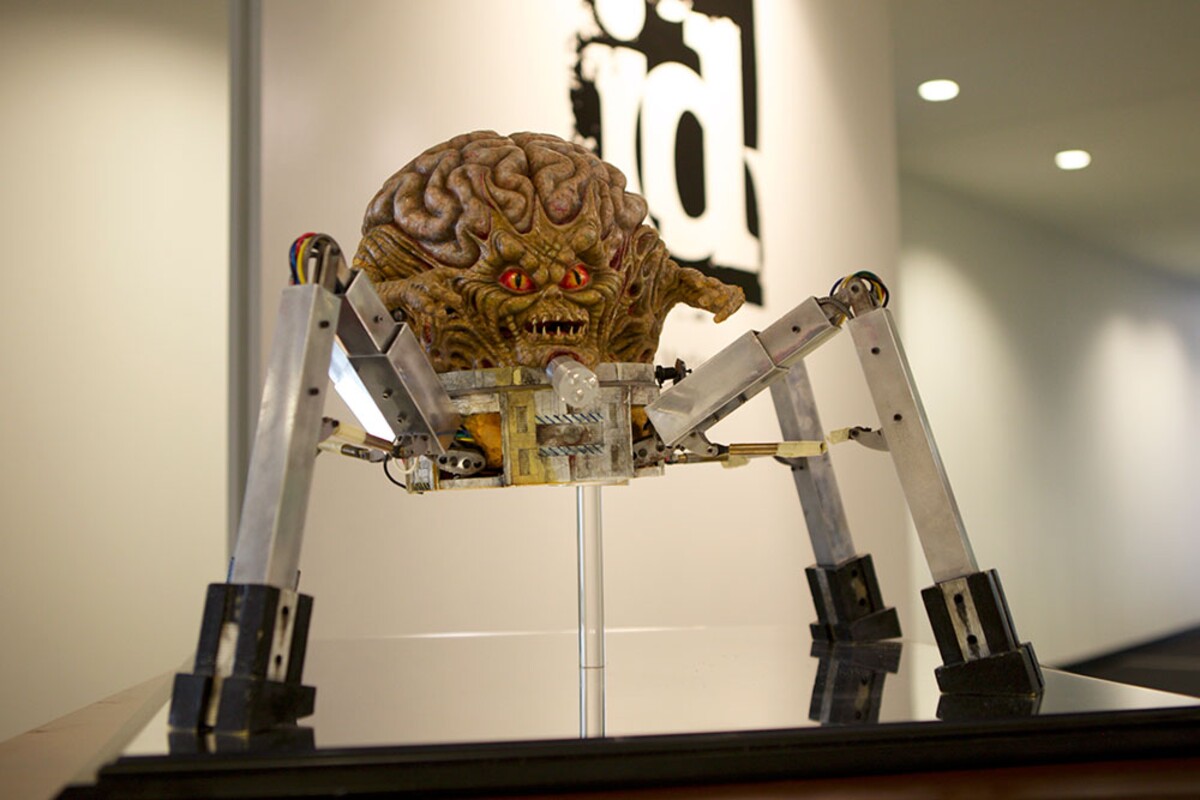

Tom Hall left them during the development of Doom. Tom has long been unhappy with the type of games Id makes. At that time, the rest of the company agreed that if someone left or was fired, they wouldn't be entitled to any bonuses or shares of future game revenues.
If we succeed, it will be the f*cking coolest game ever released on this planet.
When John Carmack finished working on the engine, he embarked on network components. The engine allowed them to connect two computers in the same room. Carmack turned on Doom and started playing on the first computer. He then saw his character move from the other player's point of view on the second computer. When Romero saw this, he shouted, "This is the shit!"
"If we succeed, it will be the f*cking coolest game ever released on this planet," said John Romero. John Carmack managed to complete multiplayer in 2 weeks. There were screams of joy, surprise and amazement echoing throughout the office.
According to the Masters of Doom book, they have only now realized the full potential of the game Doom. They have created something groundbreaking and John Romero called it Deathmatch. He immediately succumbed to it, as he finally fought against enemies capable of tactics and not just against artificial intelligence.
Blessing your timeline with this photo of John Romero and John Carmack. Creators of DOOM. pic.twitter.com/p4v0TnAPT8
— 🎃 Dave Scheidt 🎃 (@DaveScheidt) September 20, 2020
Doom has caused some servers to crash and reduction of work productivity
After a number of threatening phone calls from impatient gamers, Id Software has finally set a release date of December 10th, 1993. Just before the release though, they discovered a technical bug that made computers freeze and the game couldn't start. Huge problem for the creators. If they didn't fix it, hey'd be in some serious trouble. John Carmack corrected the mistake in the final 30 hours before the release, when the whole company was finishing the game and absolutely no one was getting any sleep at all.
They had to upload the game to the servers of the University of Wisconsin, which provided stronger connection, but it still wasn't enough. Nothing happened when they pressed the upload button. Thousands of people have been connected to the university network waiting for the first files. They couldn't upload it to the server until they temporarily banned everyone. Due to the huge interest, all servers subsequently started to crash, even in other countries, while the universities didn't understand what was happening to them with their Internet.
Doom came out only one day after various politicians, led by Senator Joseph Lieberman, criticized the violence in video games. John Romero recalls with a smile on his face: "Oh, they had no idea what was coming."
Doom was profitable right the day after its release. It was also due to the bold but revolutionary business model. They gave the retail chain the first part of the game for free. "You can keep everything, just do a good promo of the game."
If the players wanted to play the rest, they had to call Id Software directly and order the game. Id Software thus bypassed the stores, distributors and publishers. Almost 100% of sales was theirs.
Happy Birthday to Robin Williams. He was an avid video game player too. Here he is with Trent Reznor of NIN and iD Software co-founder John Carmack who made the technology behind Wolfenstein 3D, DOOM, and Quake. pic.twitter.com/rTGGwx4fOV
— GRQuake084 (MSI + Playstation) (@AdamTM24) July 21, 2020
Doom reviewers praised the game religiously, and this was before they had any idea about what the multiplayer in Deatmatch would bring. In a press release before the game's official drop, Id Software said it would be the biggest reason for a global decline in productivity at work. In the USA, this has also become a reality. Doom was installed on every computer in every office. Company directors had to schedule when their employees were allowed to play Doom so that their servers wouldn't crash.
A team of less than 10 developers at Id Software have managed to beat Bill Gates with his million-dollar Microsoft and its Windows
In 1995, Doom was installed on more computers than Microsoft Windows. Bill Gates wanted to buy Id Software, but the owners were not interested. Gates finally settled on converting Doom to Windows. The team was led by Gabe Newell, who later founded Valve, created Half-Life on an Id Software engine, and brought the revolutionary Steam game store to the world.
Doom has been a huge success on Windows, and Gates was riding along on the victorious wave. He even got himself involved into the world of Doom and fired at demons with a shotgun while talking about Windows and DirectX technology.
The arrival of Doom was accompanied by another important era of computer gaming - game mods. Carmack and Romero have released their engine freely on the Internet and opened Doom for players to customize it to any form. Instead of demons, for example, Stormtroopers from Star Wars could appear in the game.
Id Software thus offered much richer tools and better access to game changes. Thousands of different game-changing modes have been created.
Following the release of Doom, Id Software developers have become rock stars in the gaming industry. According to interviews from Masters of Doom, Romero was suddenly so popular and well-known that players bowed down in front of him on the street. John Romero enjoyed the fame, money and deatmatching in Doom.
He also participated in various fan and official tournaments (John Carmack donated his Ferrari to one tournament and an extra 5,000 dollars for the winner).
HISPANICS IN GAMES – LOVE FIRST-PERSON SHOOTERS? THANK JOHN ROMERO - https://t.co/9PbKCpWI3J pic.twitter.com/9DIDfdpDRU
— Dread Central (@DreadCentral) June 30, 2020
Romero's colleagues began to notice that he was putting in less and less work, but they didn't give it that much weight. Romero's levels were still amazing and he did a lot for both the atmosphere in the team and the promotion of the brand itself.
While Carmack worked on another revolutionary engine, the rest of the team began working on the sequel to Doom. Romero created only 6 of the 32 levels of the campaign in Doom 2. But he had big plans with Id Software. He started offering the engine to other companies, the most notable of which was the collaboration with the Raven Software studio, which also produced the games Heretic, Hexen and Hexen 2 on their engine.
Unlike Romero, Carmack wanted to have a small and focused team in a family atmosphere and also to improve his programming skills. He was not interested in turning Id Software into a million-dollar company, therefore he prohibited the sale of merchandising and other profitable activities. Id Software only had a small development team.
Key developers, Id Software personalities and the amount of years they've spent in the company
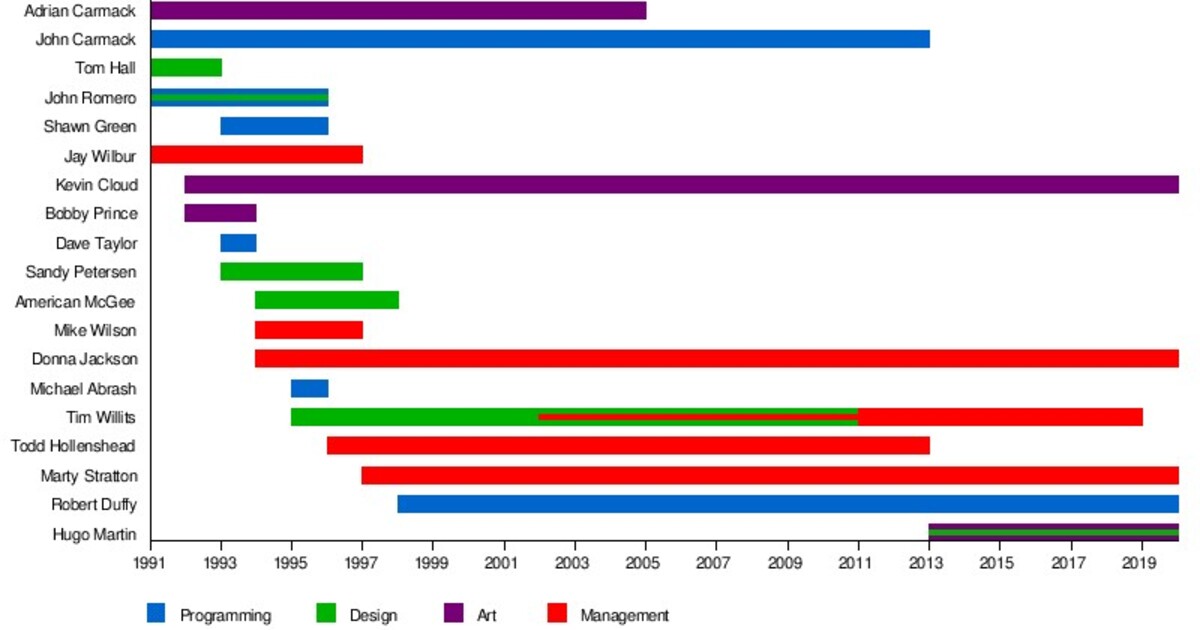
John Carmack allegedly feared that if some members were more involved in the business, the quality of their games would decline. He wasn't driven by the vision of money, fame and legend status. Carmack felt Romero moving away from the Id Software philosophy.
Once published, Doom 2 has earned millions dollars more. And this time around, the game was also released in stores. However, the three-month supply of copies only lasted a month. One day, John Romero and Jay Wilbur came to the bank in a drive-through style as if they were getting fries from McDonald’s. They handed over a 5 million dollar check to the employee. She told them with her mouth open that they could at least come inside.
Quake was supposed to beat Doom just as Doom did with Wolfenstein
Id Software was growing and John Carmack was still working on a new engine for Quake. It only took him a month to make the engine for Wolfenstein, and Doom took him half a year. The completion of the engine for Quake wasn't in sight even after half a year, so the atmosphere at Id Software was getting real intense.
Carmack has forced people to work 10 to 12 hours a day. He didn't go to work until the afternoon and became angry when people went home, even if they had been there since morning. He graded them, kept a close eye on them, and even had all the walls demolished so that he could see them all.
Quake in motion
Romero's relaxed work style was driving Carmack more and more crazy. He wanted to fire him, which wasn't supported by the other team members. Carmack even installed software on his PC to see how much of the time he was working. But even that didn't convince the others. Meanwhile, Carmack decided that the beginner levels for Quake will be created by Tim Willits, who was hired by Doom for his great modes.
Id Software's design stars, John Romero and McGee, understood that their time at the company is coming close to an end. At the time, Romero came to a conclusion that Id Software no longer enjoyed making games as much as it used to.
John Romero's departure from Id Software
He left after the Quake game was completed. He and Tom Hall founded the Ion Storm studio and received funding from Eidos Interactive to create a game called Daikatana. Only a few months after Romero's departure from Id Software, half of the team left.
Ion Storm was supposed to work differently than Id Software. Design is king and technology should come second to design, not the other way around. This time, they weren't bothered by waiting for Carmack to complete the next version of his engine anymore. They were not about creating technological revolutions, but about well-designed games. Ion Storm has signed a contract with Eidos Interactive for 100 million and a total of 6 games.
View this post on Instagram
Developers and former colleagues from Id Software and Ion Storm met at the biggest video game show of the year E3 in 1997, when Romero presented Daikatana and Carmack presented Quake 2. After playing Quake 1, Carmack improved the engine again, thanks to which he achieved further technological and graphic progress. Daikatana remained in the shadows as it used the Quake 1 engine. All Romero could say after the presentation of the Quake 2 video game was "Holy fuck".
He knew at once that they had to switch Daikatana to the Quake 2 engine, but the contract said they had to wait until Quake 2 was released. At that time, the Ion Storm studio already had dozens of developers who had nothing to work on. The idea that their games will not be subject to technology has thus vanished with the first game.
Ion Storm was costing them huge sums of money every day, and they didn't make any progress with the development of the games. In addition, renting their luxury offices had cost them 350,000 dollars each month.
View this post on Instagram
Romero realized that he wasn't capable of leading such a large team and wasn't good with money either. They complemented each other with Carmack perfectly and lacked the other's qualities in both projects. However, Id Software was better off, as it still employed only a handful of developers, while Ion Storm had almost a hundred of them on a payroll.
The development of Romero's first game after leaving Id Software was a disaster
They were still behind, though. Ion Storm developer Brian Squireel Eiserloh revealed that he worked about 85 days on a 90-day project. And that was before they decided to wait for the Quake 2 engine. As Romero said himself, he resented hiring too many amateurs from the Doom and Quake community. He had to spend a lot of time teaching them how games are actually made.
At the next edition of E3, Id Software showed Quake 3 and Valve introduced Half-Life. Daikatana was only in their shadow, and Romero refused to finish it in the engine for Quake 1. Much of Romero's team left the studio at that time.
The development of the game had already cost them 45 million dollars, but the release was in sight. It was clear that they would not comply with the agreement with Eidos, for which they had to complete five more games for a total of 100 million. Daikatana was finally released in the spring of 2000, three years later than planned. It had average reviews and sold poorly.
Daikatana
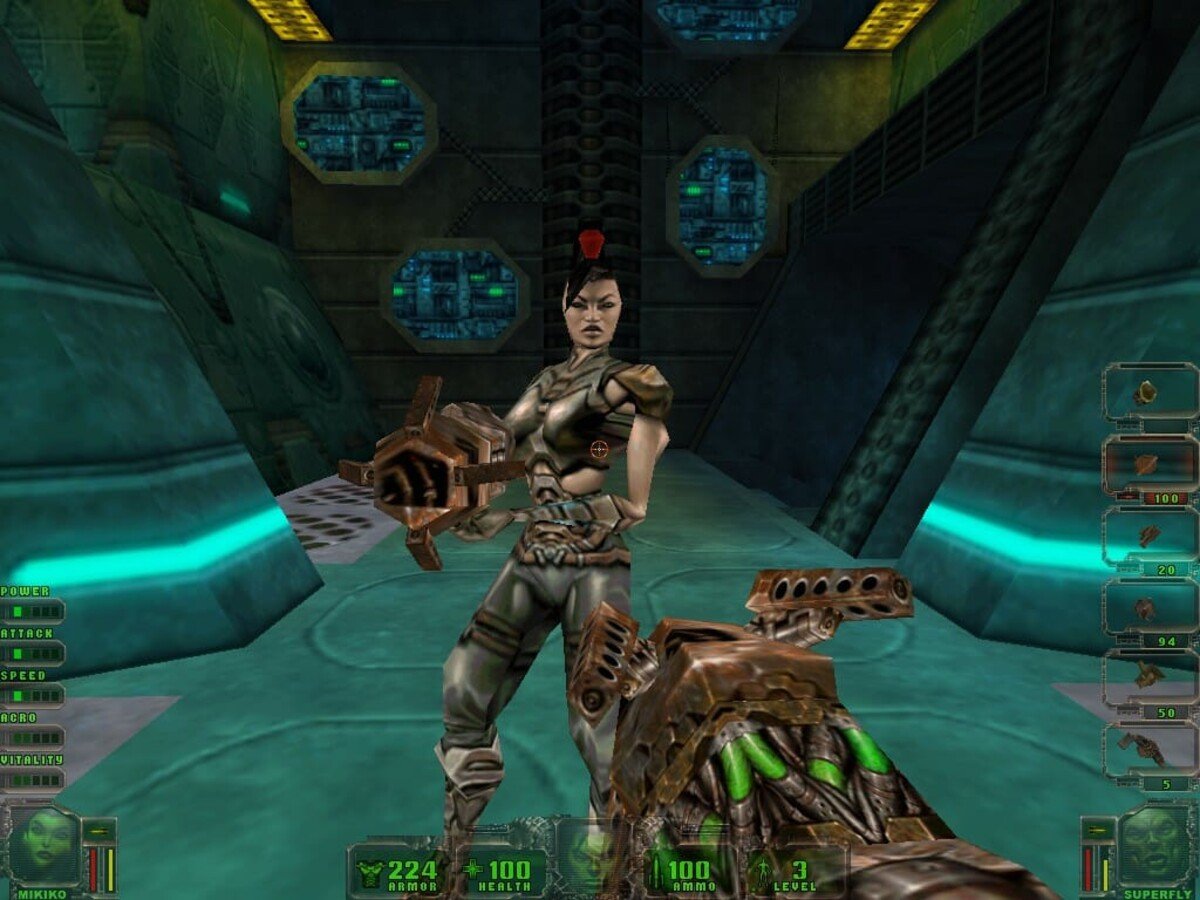
At the same time, Romero and co thoughtfully promoted the game with a poster that wrote only two sentences: "John Romero will make you his bitch" and Romero's well-known message: "Suck it down", which he used everytime when he fought someone in Doom.
Ion Storm has recovered from the worst thanks to the second team in Austin, Texas, which created Deus Ex and later Deus Ex Invisible War and Thief: Deadly Shadows. All under the guidance of the legendary Warren Specter. Romero's branch was closed and he left together with Tom Hall.
John Romero has opened six more video game companies, most of which have failed. He switched focus on production of mobile and smaller games, but he never even came close to the success of Id Software.
John Carmack was still struggling with Id Software in Ion Storm studio. They had Doom 3 in development, but no one really knew what the game would be about. Each of the 14 developers imagined the result differently and there was no one leading the project.
The problem was also that no one in Id Software actually wanted to do the third Doom. They began to have similar ideas to Romero long before - they wanted to create something original and new. But Carmack saw it differently. He threatened to leave the company if their next project wasn't Doom 3. Then they all just went along with it.
John Carmack, the last original founder of Id Software, was about to leave
However, Adrian Carmack had had enough and resigned after finishing Doom 3 in 2014. Of the original four founding members, he was the only remaining technological genius in Id Software. However, the company survived despite the growing criticism of its other games.
In 2009, it sacrificed its independence and sold Id Software to Zenimax Media, which led to them joining Bethesda Softworks. The irony is that today Bethesda belongs to Microsoft / Xbox, so Bill Gates still managed to indirectly buy Id Software after all.
The industry has changed and Id Software is no exception. John Carmack was fascinated by virtual reality, but Zenimax and Bethesda didn't want to make games purely in VR. So in 2012, Carmack decided to leave Id Software and move to Oculus, where he still works on VR technology til this day.
The upcoming Doom 4 has been canceled. The game was said to be too story-based, with a touch of film, and it simply wasn't the classic Doom. Instead, under the leadership of Hugo Martin and Marty Stratton (who has worked in Id since the time of the first Quake) , they embarked on a restart of Doom, which came out in 2016.
With the games Doom and Doom Eternal, Id Software has proved that they can still make top-notch games. The new Doom thrilled the reviewers, players and it also did well in sales. But John Carmack, John Romero, Adrian Carmack and Tom Hall were no longer there.
If problems persis, please contact administrator.



